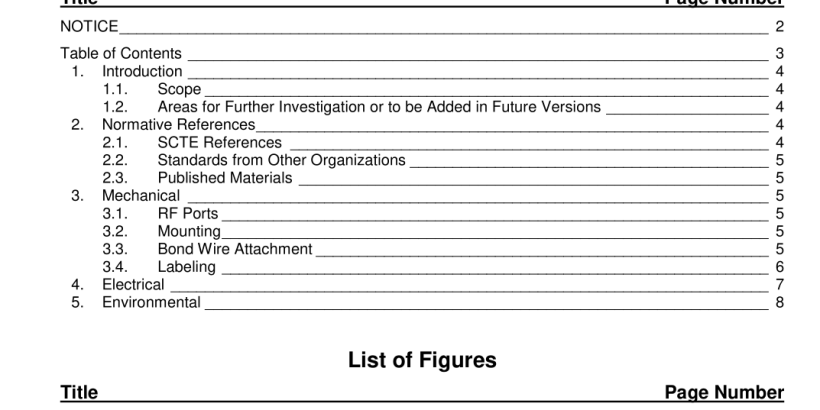ANSI SCTE 153-2016 pdf download.Drop Passives: Splitters, Couplers and Power Inserters
1.1. Scope
The purpose of this document is to recommend mechanical, environmental and electrical standards for broadband radio frequency (RF) devices whose primary purpose is to divide signals presented to an input port among two or more output ports with a fixed division ratio that is nominally independent of frequency within the specified bandwidth limits of the device. Alternately, such devices can be used to combine signals from several input ports into a common output port. Its scope is limited to 75-ohm devices whose ports are provided with type F connectors. The most common use for such devices is on- premises RF signal distribution. Products covered by this specification include signal splitters (2, 3, 4, and 8-way), directional couplers, combined splitter/directional couplers and power inserters. Devices meeting all electrical, mechanical and environmental specifications are specified as meeting the requirements of this specification. Those meeting electrical and mechanical, but not environmental requirements are designated as “Indoor Use Only” and the products must be marked as specified herein to guide users in their appropriate application. The specification is not intended to apply to specialty devices, nor is it intended to limit or restrict any manufacturer’s innovation and improvement.
1.2. Areas for Further Investigation or to be Added in Future Versions
This document provides specifications or procedures for frequencies up to 1002 MHz. DOCSIS 3.1 specifications include operation at frequencies up to 1218 MHz, and optionally, to 1794 MHz. Specifications or procedures for those higher frequencies should be considered in a future revision of this document.
2. Normative References
The following documents contain provisions, which, through reference in this text, constitute provisions of this document. At the time of Subcommittee approval, the editions indicated were valid. All documents are subject to revision; and while parties to any agreement based on this document are encouraged to investigate the possibility of applying the most recent editions of the documents listed below, they are reminded that newer editions of those documents might not be compatible with the referenced version.
3.4. Labeling
Each port of the device must be labeled. Designations must be in accordance with the following:
1. The common port may be labeled “COMMON”, “IN” or “INPUT” at the manufacturer’s option.
2. In the case of splitters, each of the splitter output ports may be labeled “OUT” or “OUTPUT” and may include a port number at the manufacturers option. Each port must also indicate the nominal loss from the input to that port in the form “-n dB” where n is the nominal loss. The “Nominal Loss” is the manufacturer’s specified highest rated frequency loss rounded up to the next 0.5 dB.
3. In the case of directional couplers, the port receiving the greatest percentage of the input signal may be labeled “THRU”, “THROUGH”, “OUT”, “OUTPUT” or other clearly understood term, at the manufacturers option. The port receiving the lower percentage of the input signal shall be labeled “TAP” and must also be labeled with the nominal loss from the input in the form “-n dB”, where “n” is the nominal loss in dB.
4. In the case of Power Inserters, the Power port may be labeled as “DC”, “AC” or “PWR”. The port with RF only should be labeled “RF” or “TV”, and the port with power and RF should be labeled “RF + PWR”, “AC”, or other clearly understood term, at the manufacturers option. Maximum voltage must also be stated.
5. So long as the function of each port is clear and the loss from the input to each output port is clear, manufacturers may use any labeling layout they choose. See Figure 2 for an example of conforming labeling.
6. All labels must incorporate the manufacturers model number and rated bandwidth of the device.
7. Devices which do not meet the environmental criteria as specified in section 4.2 shall be labeled “For Indoor Use Only”. 8. Labeling shall be designed to be legible for a period of at least 10 years under typical environmental exposure and handling.ANSI SCTE 153-2016 pdf download
